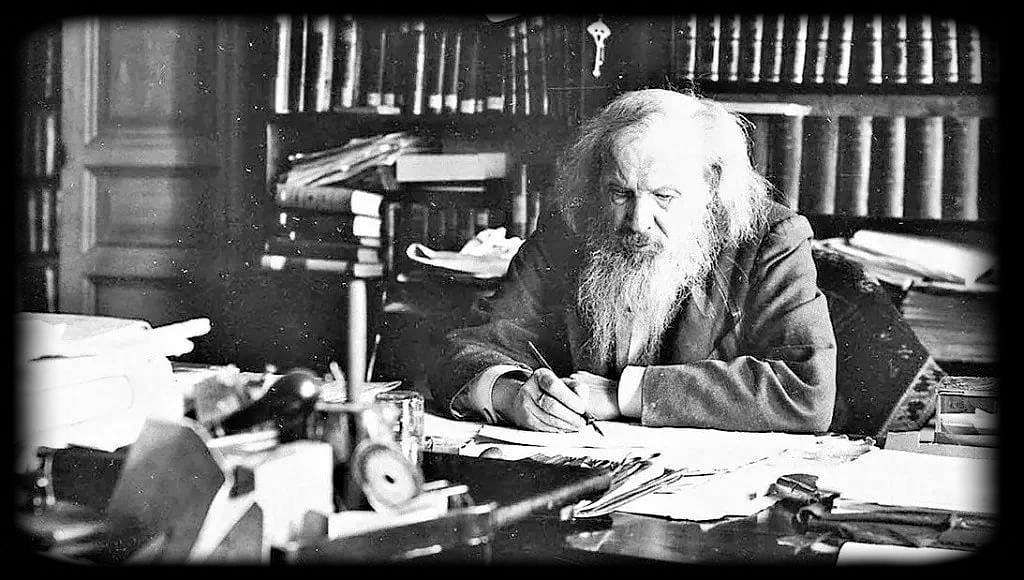In 1869, Dmitri Mendeleev, a Russian chemist, introduced the periodic table, revolutionizing the field of chemistry with his systematic organization of chemical elements. Prior to Mendeleev’s groundbreaking work, chemists struggled with inconsistencies in grouping elements by atomic weight. His innovative arrangement not only revealed patterns and periodic trends but also predicted undiscovered elements. Mendeleev’s contribution laid the foundation for modern chemistry, raising questions about the evolution of scientific frameworks and their enduring impact.
Introduction

A Pivotal Figure
Dmitri Mendeleev emerged as a pivotal figure in the quest to systematize chemical knowledge during the 19th century. Born in Tobolsk, Siberia, Mendeleev’s background was marked by a keen intellect nurtured within the burgeoning Russian scientific community. His education in St. Petersburg exposed him to early chemistry influences, fostering a passion that would redefine the discipline.
The Periodic Table Emerges

In 1869, the scientific landscape was transformed when Dmitri Mendeleev introduced the periodic table. This innovative framework organized elements based on their atomic weights and properties, revealing a repetitive pattern and offering unprecedented element classification. This breakthrough held immense scientific significance, providing a predictive model that anticipated undiscovered elements, thereby reshaping the historical context of chemistry. It transcended mere cataloging, altering the educational impact of chemistry by emphasizing underlying principles over rote memorization.
The State of Chemistry Before
Before Mendeleev’s groundbreaking work, the field of chemistry was characterized by a fragmented understanding of elements and their properties. The evolution from alchemy to modern chemistry was underway, yet element classification remained rudimentary. Scholars were grappling with atomic theory, lacking a cohesive framework for organizing chemical symbols. This period saw burgeoning scientific collaboration, yet the absence of a systematic approach hindered progress. Pioneers like Dalton and Berzelius laid foundational work, but their efforts lacked integration. Chemists sought an innovative structure that could synthesize disparate discoveries into a coherent whole, paving the way for Mendeleev’s transformative periodic table.
Challenges and Obstacles
Despite the burgeoning knowledge of chemical elements in the 19th century, chemists faced significant obstacles in organizing them systematically. The challenge lay in devising an effective element classification system that accommodated both chemical properties and atomic weight. At the time, inconsistencies in measured atomic weights compounded the difficulty, obscuring patterns essential for coherent organizational methods. Additionally, the lack of standardized scientific collaboration hindered the sharing of data and ideas, leading to fragmented approaches. The absence of a thorough framework meant chemists struggled to predict the properties of elements, highlighting the urgent need for innovative solutions in the evolving field of chemistry.
Precursors to Mendeleev
Although the quest to classify elements systematically was fraught with challenges, significant strides were made by scientists like John Alexander Reina Newlands and Lothar Meyer. Newlands’ classification, known as the Law of Octaves, proposed that every eighth element shared similar chemical properties, drawing inspiration from musical scales. However, its rigid application to all known elements limited its acceptance. Concurrently, Lothar Meyer’s work emphasized periodicity, arranging elements by atomic volume and highlighting recurring patterns. Despite their innovative approaches, both Newlands and Meyer laid the groundwork for future advancements.
Mendeleev’s Unique Approach

Mendeleev’s approach to classifying the elements marked a significant advancement by leveraging both empirical data and intuitive insight. Unlike his predecessors, Mendeleev’s methodology was rooted in recognizing periodic trends and arranging elements by atomic weight while leaving intentional gaps for undiscovered elements. This strategic foresight demonstrated unparalleled predictive accuracy, allowing for the anticipation of properties of future elements, thereby solidifying his element classification system’s robustness. Mendeleev’s visionary approach transcended mere categorization; it established a scientific legacy that integrated theoretical insights with practical predictions, surpassing earlier efforts by emphasizing coherence and clarity in understanding elemental relationships.
The Moment of Breakthrough
The moment of breakthrough in Dmitri Mendeleev’s work emerged through the synthesis of meticulous observation and innovative foresight. His revolutionary methodology aimed for a systematic classification of elements. He discerned periodic patterns within elemental properties, leading to a transformative understanding of chemical behavior. His insight enabled chemical predictions, forecasting undiscovered elements with unprecedented accuracy. By arranging elements according to atomic mass and properties, Mendeleev established a scientific legacy that reshaped modern chemistry. His periodic table not only classified known elements but anticipated future discoveries, solidifying his role as a pivotal figure in the advancement of chemical science.
Mendeleev’s Vision for Chemistry
 While immersed in writing a chemistry textbook, Dmitri Mendeleev recognized the need for a more coherent organization of the elements based on their inherent characteristics. Mendeleev’s vision extended beyond the chaotic elemental listings of his time, aiming for systematic elemental classification. This approach focused on uncovering patterns in atomic weights and properties, fundamentally altering chemistry education. His insights catalyzed textbook evolution, offering a foundation where characteristic focus provided clarity. By aligning elements according to shared traits, Mendeleev enhanced comprehension and fostered an innovative framework that would influence future scientific inquiry.
While immersed in writing a chemistry textbook, Dmitri Mendeleev recognized the need for a more coherent organization of the elements based on their inherent characteristics. Mendeleev’s vision extended beyond the chaotic elemental listings of his time, aiming for systematic elemental classification. This approach focused on uncovering patterns in atomic weights and properties, fundamentally altering chemistry education. His insights catalyzed textbook evolution, offering a foundation where characteristic focus provided clarity. By aligning elements according to shared traits, Mendeleev enhanced comprehension and fostered an innovative framework that would influence future scientific inquiry.
Presenting the Periodic Table
In a moment of scientific clarity, Dmitri Mendeleev presented his periodic table to the Russian Chemical Society on March 6, 1869 (March 18 in the modern Gregorian calendar). Set against the 19th century’s burgeoning scientific inquiry, Mendeleev’s Presentation marked a pivotal advancement. The Chemical Society, a hub for intellectual exchange, witnessed the revelation of a systematic classification of elements. This underscored the scientific impact of Mendeleev’s work, establishing a framework that enabled future discoveries and innovations in chemistry, transforming theoretical understanding into practical application.
The Table’s Structural Ingenuity
Following Mendeleev’s groundbreaking presentation, attention turned to the structural ingenuity of his periodic table. Its initial layout featured elements strategically organized into rows and columns, revealing periodic trends. This innovative element classification allowed for a coherent understanding of chemical behavior, with elements aligned by increasing atomic weight. Mendeleev’s rows (periods) and columns (groups) highlighted shared properties, paving the way for predictive insights. This meticulous framework transformed the abstract into the tangible, providing an all-encompassing map of elemental relationships.
Recognizing Periodicity
Amidst the 19th-century chemical landscape, Dmitri Mendeleev’s pivotal contribution lay in recognizing periodicity in the properties of elements as their atomic weight increased. This insight laid the foundation for understanding periodic trends, revolutionizing element classification. Observing that chemical properties recurred at regular intervals, Mendeleev’s influence reshaped scientific thought, offering a systematic approach to predicting unknown elements.
What Made Mendeleev’s Table Special
 Mendeleev’s table distinguished itself from previous attempts due to its innovative structure and predictive capability. His methodology involved arranging elements by increasing atomic weight, revealing periodic trends in properties. Unlike his predecessors, Mendeleev emphasized the significance of periodicity, leading to a coherent element classification system. Rooted in scientific collaboration, his approach drew on the works of his contemporaries to refine historical accuracy. This method allowed the table to adapt and evolve as new data emerged, cementing its role as a dynamic tool for chemists and laying groundwork for future elemental discoveries.
Mendeleev’s table distinguished itself from previous attempts due to its innovative structure and predictive capability. His methodology involved arranging elements by increasing atomic weight, revealing periodic trends in properties. Unlike his predecessors, Mendeleev emphasized the significance of periodicity, leading to a coherent element classification system. Rooted in scientific collaboration, his approach drew on the works of his contemporaries to refine historical accuracy. This method allowed the table to adapt and evolve as new data emerged, cementing its role as a dynamic tool for chemists and laying groundwork for future elemental discoveries.
Foresight and Prediction
Despite the limitations of his era’s scientific knowledge, Dmitri Mendeleev’s periodic table was revolutionary in its foresight, as it left intentional gaps for elements yet to be discovered. Mendeleev’s predictions demonstrated remarkable scientific intuition, as he forecast properties of missing elements with striking accuracy. This predictive prowess showcased his understanding of periodic trends, where he anticipated not only the existence but also the atomic weights and chemical behaviors of elements like gallium and germanium. These forecasts were later validated, reinforcing his legacy.
Recalibrating Atomic Weights
In his quest to refine the periodic table, Dmitri Mendeleev recalibrated the atomic weights of certain elements to ensure they aligned with the table’s emerging pattern. These atomic weight adjustments were pivotal in ensuring the coherence of element classification methods. Through meticulous periodic trends analysis, Mendeleev identified discrepancies between calculated weights and expected chemical behaviors. Altering these values to fit the observed periodicity, demonstrated profound innovation and foresight. These adjustments not only solidified the structural integrity of the table but also greatly influenced modern chemistry, paving the way for subsequent discoveries in elemental science.
Arranging by Properties
Having recalibrated atomic weights to align with periodic trends, the next step in refining the periodic table was to arrange elements according to their chemical properties. Dmitri Mendeleev sought to enhance element classification by grouping elements with similar atomic properties and chemical behavior. This disclosed profound insights into element similarities, allowing for a coherent framework where patterns of reactivity and valency emerged naturally.
Lasting Impact

Mendeleev’s periodic table stands as a demonstration to the predictive power of scientific frameworks. His system of element classification transcended existing knowledge, showcasing remarkable foresight.
The gallium discovery in 1875 aligned closely with Mendeleev’s earlier scandium prediction, adding empirical weight to his theoretical model. Furthermore, germanium’s match with his proposed properties further validated Mendeleev’s accuracy.
Each discovery reinforced the periodic table’s reliability, confirming the chemical behavior and properties he postulated. These confirmations were not mere coincidences but a proof of the robustness of Mendeleev’s methodology, solidifying the periodic table as an indispensable tool in the advancement of chemistry.
As scientific understanding progressed, the periodic table underwent significant transformations, reflecting the dynamic nature of chemistry itself.
Initially, element classification methods grappled with historical scientific challenges, seeking patterns within known elements. Mendeleev’s legacy lies in his innovative approach to predict undiscovered elements, which validated his periodic arrangement.
This foresight set the stage for the periodic table’s evolution into a sophisticated framework. Adjustments over time addressed elemental anomalies and integrated new discoveries, solidifying its status as a cornerstone of modern chemistry tools.
Mendeleev’s legacy endures, yet the atomic number-based arrangement exemplifies the periodic table evolution essential for scientific progress.
Conclusion

The concept of scientific progress is exemplified through the evolution of the periodic table, highlighting the dynamic nature of human understanding.
Mendeleev’s legacy is not just the table itself but the collaborative framework it inspired among scientists. Grounded in predictive power, the periodic table has facilitated numerous element discoveries, ensuring its pivotal role in advancing chemical sciences.
By revealing periodic trends, it has become an indispensable educational tool, shaping curricula worldwide. Through scientific collaboration, the periodic table continues to evolve, reflecting the ever-expanding boundaries of knowledge.
Its impact on education and research underscores its enduring significance in modern chemistry.
Mendeleev’s pioneering work on the periodic table stands as a demonstration of his profound impact on the field of chemistry. His systematic arrangement of elements not only revealed the underlying order in chemical behavior but also revolutionized the understanding of chemical relationships.
Mendeleev’s legacy endures through the global recognition of his scientific brilliance, marking a pivotal turn in chemistry evolution. His table provided predictive power that underscored its educational significance, enabling learners worldwide to grasp complex chemical concepts.
In the domain of scientific education and research, the periodic table remains an indispensable tool, serving as the backbone of chemical understanding. Integrated into the science curriculum, it provides a structured framework that guides educational resources and classroom activities.
By exploring periodic trends, students gain insights into elemental behavior, fostering a deeper comprehension of chemical principles. In research, it underpins innovative methods, enabling scientists to predict reactivity and synthesize novel compounds.
Its enduring relevance lies in its ability to adapt to new scientific discoveries, continually enriching educational paradigms and empowering future generations to push the boundaries of scientific knowledge.





